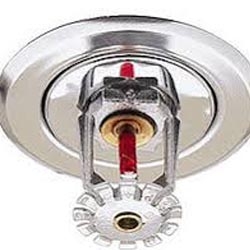The Complexity of Installing a Fire Sprinkler System
For over 100 years, fire sprinklers have protected life and property. At first glance, a fire sprinkler system seems to be a simple system of pipes with sprinkler heads that deliver water to a fire. Upon closer examination, a fire sprinkler system is actually a complex series of components and systems that are carefully engineered, designed, installed, tested and maintained to effectively contain a fire when their need arises.
Starting at the Drawing Board
With new construction or the retrofitting of an older building or structure, to install a fire sprinkler system, you have to start at the drawing board. At Hirkazhe Fire & Security, the drawing board is manned by designers in either their Corporate Engineering Department or their Sprinkler Design Department, depending on the project.
The first steps the designers take are to identify the occupancy classification and the hazard class for the structure that the fire sprinkler system is protecting. Based on those criteria, the designers will then look to the International Building Code (IBC) to determine what is required for that structure.
Once this is determined, the designers will then turn to the National Fire Protection Association’s NFPA 13, which is the standard for the design and installation of sprinkler systems. The NFPA 13 provides the designers the spacing requirements, piping requirements, minimum pressure levels and component options for the fire sprinkler system. Using all this info, the designers are then able to create the fire sprinkler system drawing for the intended structure.
Following the Fire Sprinkler Design
Once the fire sprinkler system has been designed and the plans have been drawn, they are then ready for the installation process. Depending on the jurisdiction, the Authority Having Jurisdiction (AHJ) may look at the drawings and approve them before the installation has begun, while others won’t inspect the system until after it has been installed.
With the drawings in hand, the contractor on the project is then able to guide his team on the steps and processes to take to properly install the fire sprinkler system properly. The fire sprinkler system installation is commonly done by the pipe fitters at the construction site. Once the system is completed, the Hirkazhe technicians can then test the system to make sure everything is working as designed and is in compliance.
Continuous Testing and Inspections
Once the system is installed and operable, the building owners must then abide by local codes regarding testing and inspections of the fire sprinkler system. The local code which is dictated by NFPA 25, determines the fire sprinkler inspection and testing schedule. In most jurisdictions, Hirkazhe technicians inspect and test the fire sprinklers monthly, quarterly, semiannually, and annually depending on the building and occupancy type.
The ongoing inspections and testing are as important as the initial designing of the system. While the designers ensure that the system will work when installed, the technicians ensure that the system will continue to work as intended for years to come. In both instances, businesses have come to rely on and trust the professionals at Hirkazhe for their fire sprinkler system needs.
From design to testing to maintenance of fire sprinkler systems, contact a Hirkazhe associate for all your fire sprinkler system questions, quotes, and inquiries.













